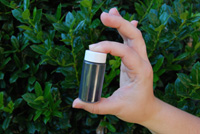Editorial
Front Page - Friday, September 10, 2010
State of Tennessee urges radon testing, offering free kits
David Laprad
 Indoor radon is the second-leading cause of lung cancer in the United States. Free test kits, such as the one in this picture, make detecting the radioactive gas simple. In addition, specially designed ventilation systems have been shown to be effective in removing radon.
- David Laprad
Indoor radon is the second-leading cause of lung cancer in the United States. Free test kits, such as the one in this picture, make detecting the radioactive gas simple. In addition, specially designed ventilation systems have been shown to be effective in removing radon.
- David Laprad
In a National Health Advisory issued in January 2005, U.S. Surgeon General Richard Carmona warned the American public about the risks of breathing indoor radon.
“Indoor radon is the second-leading cause of lung cancer in the United States, and breathing it over prolonged periods can present a significant health risk to families all over the country,” he said.
Radon is a naturally occurring radioactive gas produced during the normal decay of uranium found in the Earth’s crust. It is a colorless, odorless and tasteless radioactive gas that crops up naturally in most rocks and soils, and is harmlessly dispersed in outdoor air. However, when radon is trapped in buildings, especially at elevated levels, in can increase the risk of lung cancer.
“Air pressure inside your home is usually lower than the pressure in the soil around and under your home. Because the pressure is lower inside, radon can move into homes through cracks, sump pumps, well water supplies and other openings. All homes and structures are susceptible to radon,” says Amy Little, coordinator of the radon program at the Office of Environmental Assistance (OEA), which is part of the Tennessee Department of Environment and Conservation (TDEC).
According to the TDEC, radon causes more than 21,000 lung cancer deaths each year. Daily exposure at four picocuries of radon, or four units of radioactivity per liter, is the same as smoking half a pack of cigarettes per day. Smokers exposed to radon are at a greater risk of developing lung cancer.
The Environmental Protect-ion Agency estimates that over 70 percent of Tennessee’s population lives in moderate to high risk radon areas. In Hamilton County, one in five homeowners are at risk, according to the TDEC.
The good news is that the threat is preventable, as radon can be detected with a simple test and fixed through well-established ventilation techniques.
The OEA has made testing easy for Tennesseans. To obtain a test kit, families or individuals can call the office at 800-232-1139 and request one. The kit will arrive in the mail complete with instructions and a postage paid envelope for mailing the kit to a laboratory after testing is complete. Because the State of Tennessee has funded the program, the kit is available at no cost. The lab work and report are also free.
“You have to place the kit in the lowest livable level of your home for two to seven days. There’s a little bit of paperwork involved, too. After you mail the kit to the laboratory, you’ll receive a letter with your test results in one to two weeks,” Little says.
Little recommends testing a second time if the results show a reading of 4.0 or more picocuries. When the OEA sends the subsequent kit, it will include a list of people who are nationally certified to do radon mitigation.
“Tennessee does not have rules or regulations about radon, so we don’t have a certification process. However, there are two national organizations that do certify people: the National Environmental Health Association and the National Radon Safety Board,” Little says.
The EPA recommends home-owners with a reading of 2.0 to 3.9 picocuries install a radon mitigation system, as even low levels of the gas have been shown to cause trouble. Little says systems cost between $1,200 and $2,000, and involve only a few moving parts, so there’s little maintenance involved. She also says they are “highly effective” in diminishing radon.
Radon became a matter for concern in the 1980s, when a Pennsylvania man who worked at a nuclear power plant that was not yet operational kept setting off the alarms. Those involved in investigating why eventually discovered radon in his home. The level of the gas was so high, the man had to move.
No one has reported an incident on that scale in Tennessee, Little says, although the OEA has designated 38 counties as having a high potential for indoor radon problems.
As a result, the TDEC recommends Tennesseans test their homes for radon every two years, and retest when they make structural changes to their homes. For high radon counties in Tennessee, which do not include Hamilton County, the department recommends the following: (1) When building a home, install one of more radon escape stacks at the time of construction; (2) when purchasing a home, require a radon test prior to closing; and (3) occupants of existing homes in high radon counties should test their homes for excessive radon and install a removal system if necessary.
Little says the OEA ships out about 7,000 radon test kits a year, so word of the threat is spreading.
“The only way to know is to test, so we’re urging everyone to do so,” she says.
For more information about radon and radon testing, visit www.tdec.net/ea/radon.
|
|